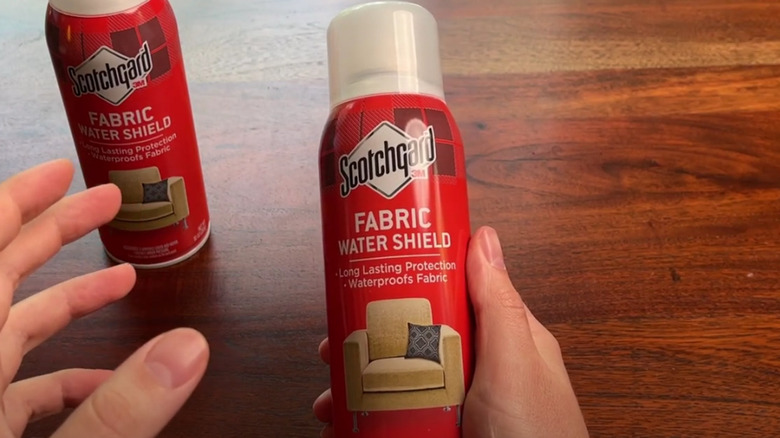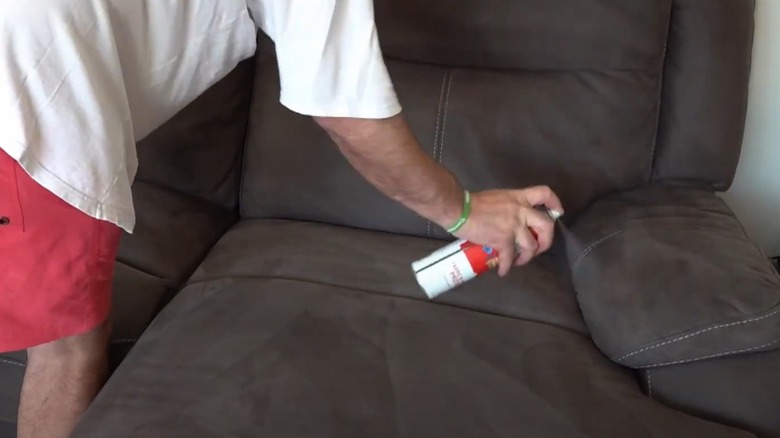Fabrics You Can Safely Treat At Home With Scotchgard Fabric Water Shield
We may receive a commission on purchases made from links.
When you're looking for a product to protect your fabrics from spills, you've probably heard the pros and cons of using Scotchgard Fabric Water Shield. This fabric protector is available inexpensively ($13.26 for a 2-pack on Amazon) and does the job by making fabrics repellent to water-based spills. Many people even use Scotchgard on items you carry with you in the elements, like your handbags or backpacks. However, it doesn't work on every fabric. In fact, it could damage some fabrics if not used correctly.
Scotchgard Fabric Water Shield is safe to use on nearly any fabric that you could put into a washing machine, including acrylic, cotton, nylon, polyester, and silk. You can use this spray on a variety of items, including backpacks, clothing, throw pillows, purses, canvas shoes, luggage, and furniture. Scotchgard Fabric Water Shield is safe to use around kids and pets, as long as they don't touch the fabric application until the spray dries. After it dries, the surface of the fabric should not change, meaning clothing remains comfortable to wear. Even Joanna Gaines says Scotchgard makes cleaning easier and protects furniture from kids and spills.
However, you may have heard about fabrics suffering ink bleed and color changes after using Scotchgard Fabric Water Shield, making you leery about using it. If you're still unsure about using this spray on your furniture and clothing at home, learn more about the fabrics and surfaces that are safe to use it on and which are not, as well as the best way to use this product safely.
How to figure out which fabrics are safe to use with Scotchgard Fabric Water Shield (and which aren't)
As a general rule, you can use Scotchgard Fabric Water Shield on any fabrics that you can clean with water and liquid cleaning products. However, it's important to never use Scotchgard Fabric Water Shield on products that have a "code X" on the sewn-in label. The code X designation indicates a fabric that should not have any water or cleaning product applied to it. You should only clean code X fabric by vacuuming or by using a gentle, dry brush. Fabrics designated as code X include some types of leather and velvet.
To look for the code X mark, find the sewn-in tag for the bag, clothing, or other type of fabric. Some tags are under the cushions, sewn directly to the piece of furniture. The tag may have one or more cleaning codes listed in English, especially with furniture. Other types of fabrics, especially clothing, may use symbols to indicate any cleaning restrictions. If you see a symbol for "do not wash," which may look like a basin with water in it and an X over the top of the symbol, you should not use water on it for cleaning, so you shouldn't use Scotchgard Fabric Water Shield on it, either.
How to apply Scotchgard Fabric Water Shield and how to test it on fabric
Always follow the directions for applying the Scotchgard Fabric Water Shield to ensure safety. Shake the can before use and hold it about 6 inches from the fabric. Use a sweeping motion to apply the spray, then allow it to dry completely before touching it or using it.
You don't want to make a big mistake by Scotchgarding your furniture and causing damage to the fabric. The best way to ensure a safe application is to test the Scotchgard Fabric Water Shield before you apply it. You should test the spray to ensure colorfastness. Use the spray in an area of the fabric that is not easily seen. Allow it to dry completely. Wipe the area with a white cloth after it dries to see if any of the color from the fabric transfers to the cloth. You also should check the area where you sprayed for significant changes in color after application. (Scotchgard says fabrics may have a slightly darker, richer tone after application, and this is normal.) If either problem occurs, you should not use Scotchgard Fabric Water Shield on that fabric.
Be careful that you do not have overspray that hits fabrics or objects that you did not test. If you do have any overspray, wipe it up immediately. Scotchgard recommends using two light coats of spray on your fabrics, rather than one heavy coat.


